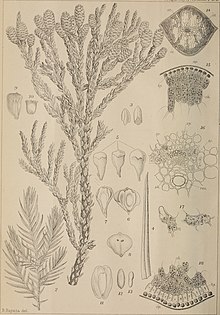Taiwania
| Taiwania Temporal range:
| |
|---|---|

| |
| Scientific classification | |
| Kingdom: | Plantae |
| Clade: | Tracheophytes |
| Clade: | Gymnospermae |
| Division: | Pinophyta |
| Class: | Pinopsida |
| Order: | Cupressales |
| Family: | Cupressaceae |
| Subfamily: | Taiwanioideae |
| Genus: | Taiwania Hayata |
| Species: | T. cryptomerioides
|
| Binomial name | |
| Taiwania cryptomerioides | |
| Synonyms[2] | |
| |
Taiwania, with the single living species Taiwania cryptomerioides, is a large coniferous tree in the cypress family Cupressaceae.
Etymology
Taiwania means 'from Taiwan', while cryptomerioides means 'resembling Cryptomeria.[3]
Taxonomy
The genus was formerly placed in the segregate family Taxodiaceae, it is now included in the monotypic subfamily Taiwanioideae of the family Cupressaceae.[4] It is the second most basal member of the living Cupressaceae, with only Cunninghamia being more basal. Its lineage is thought to have diverged from the rest of Cupressaceae during the Middle Jurassic.[5] The oldest fossil assignable to the genus is from the mid-Cretaceous (Albian-Cenomanian) of Alaska.[6] Other fossils of the genus are known from the Late Cretaceous of Asia, the Eocene of Asia and North America, and the Miocene of Europe and Asia.[7]
Range


It is native to eastern Asia, growing in the mountains of central Taiwan, and locally in southwest China (Guizhou, Hubei, Sichuan, Yunnan, Tibet) and adjoining Myanmar, and northern Vietnam.[2][4] It is endangered by illegal logging for its valuable wood in many areas. It is very likely that the range was more extensive in the past before extensive felling for the wood.[1] The populations in mainland Asia were treated as a distinct species Taiwania flousiana by some botanists, but the cited differences between these and the Taiwanese population are not consistent when a number of specimens from each area are compared.
Morphology
It is one of the largest tree species in Asia, reported to heights of up to 90 m (300 ft) tall and with a trunk up to 4 m (13 ft) diameter above buttressed base.[8] The leaves are needle-like or awl-like and 8–15 mm (0.31–0.59 in) long on young trees up to about 100 years old, then gradually becoming more scale-like, 3–7 mm (0.12–0.28 in) long, on mature trees. The cones are small, 15–25 mm (0.59–0.98 in) long, with about 15–30 thin, fragile scales, each scale with two seeds.
History
The genus is named after the country of Taiwan, from where it first became known to the botanical community in 1910.
The wood is soft, but durable and attractively spicy scented, and was in very high demand in the past, particularly for temple building and coffins. The rarity of the tree and its slow growth in plantations means legal supplies are now very scarce; the species has legal protection in China and Taiwan.
Taiwania is also a journal that is published by National Taiwan University in Taiwan.
Extraordinary specimens
In 2022 a team of researchers measured a 79.1 meters (259.5 feet) Taiwania specimen in Shei-pa National Park. The tree was growing at an elevation of 2,000m.[9]
In 2023 a specimen was found measuring 84.1 meters in height.[10]
References
- ^ a b Thomas, P. & Farjon, A. (2011). "Taiwania cryptomerioides". The IUCN Red List of Threatened Species. 2011. IUCN: e.T31255A9620141. doi:10.2305/IUCN.UK.2011-2.RLTS.T31255A9620141.en. Retrieved 15 January 2018.
- ^ a b "Taiwania". World Checklist of Selected Plant Families (WCSP). Royal Botanic Gardens, Kew.
- ^ Gledhill, David (2008). "The Names of Plants". Cambridge University Press. ISBN 9780521866453 (hardback), ISBN 9780521685535 (paperback). pp 127, 370
- ^ a b Fu, Liguo; Yu, Yong-fu; Mill, Robert R. "Taiwania cryptomerioides". Flora of China. Vol. 4 – via eFloras.org, Missouri Botanical Garden, St. Louis, MO & Harvard University Herbaria, Cambridge, MA.
- ^ Stull, Gregory W.; Qu, Xiao-Jian; Parins-Fukuchi, Caroline; Yang, Ying-Ying; Yang, Jun-Bo; Yang, Zhi-Yun; Hu, Yi; Ma, Hong; Soltis, Pamela S.; Soltis, Douglas E.; Li, De-Zhu (July 19, 2021). "Gene duplications and phylogenomic conflict underlie major pulses of phenotypic evolution in gymnosperms". Nature Plants. 7 (8): 1015–1025. doi:10.1038/s41477-021-00964-4. ISSN 2055-0278. PMID 34282286. S2CID 236141481.
- ^ Lepage, Ben A. (April 2009). "Earliest Occurrence of Taiwania (Cupressaceae) from the Early Cretaceous of Alaska: Evolution, Biogeography, and Paleoecology". Proceedings of the Academy of Natural Sciences of Philadelphia. 158 (1): 129–158. doi:10.1635/053.158.0107. ISSN 0097-3157. S2CID 129574364.
- ^ Atkinson, Brian A.; Contreras, Dori L.; Stockey, Ruth A.; Rothwell, Gar W. (August 2021). "Ancient diversity and turnover of cunninghamioid conifers (Cupressaceae): two new genera from the Upper Cretaceous of Hokkaido, Japan". Botany. 99 (8): 457–473. doi:10.1139/cjb-2021-0005. ISSN 1916-2790. S2CID 237705866.
- ^ Farjon, A. (2005). Monograph of Cupressaceae and Sciadopitys. Royal Botanic Gardens, Kew. ISBN 1-84246-068-4
- ^ Everington, Keoni (21 October 2022). "Tallest tree in East Asia discovered in Taiwan". taiwannews.com.tw. Taiwan News. Retrieved 22 October 2022.
- ^ Hsiung-feng, Chang; Mazzetta, Matthew (30 January 2023). "84.1-meter Taiwania tree confirmed as Taiwan's tallest". focustaiwan.tw. Focus Taiwan. Retrieved 30 January 2023.
External links
- Articles with short description
- Short description is different from Wikidata
- IUCN Red List vulnerable species
- Articles with 'species' microformats
- Commons link is on Wikidata
- Webarchive template wayback links
- Taxonbars with 20–24 taxon IDs
- Cupressaceae
- Monotypic conifer genera
- Trees of Myanmar
- Trees of China
- Trees of Taiwan
- Trees of Vietnam
- Vulnerable plants

